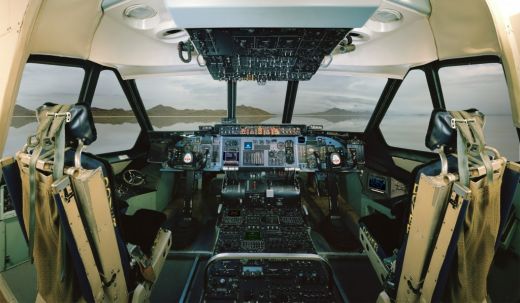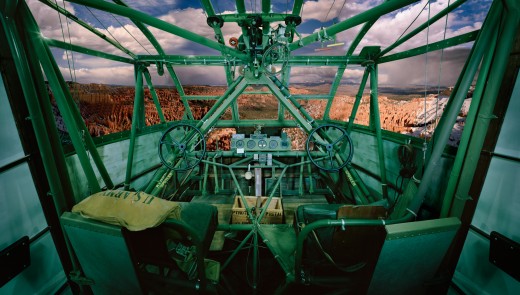Luis Gispert, Tender Game
Hunter Braithwaite

Luis Gispert, C-5 Fat Fred, 2013. C-print. 65 x 120". Photo courtesy artist and David Castillo Gallery
February 6 – March 29, 2014
An elegant fleet of Luis Gispert’s photographs turns David Castillo Gallery into a theater of war. Five large-scale c-prints match the cockpits of 20th– century American military planes with sublime backdrops from both the States and abroad. While the show isn’t a departure for Gispert (he’s been doing these inside-out jobs for a while now) it is a stunning addition that further validates an already important body of work.
The closest connections to these pieces were shown at the Mary Boone Gallery in 2011 as part of Gispert’s Decepción exhibition. There, the Jersey-born, Miami-raised artist paired similar backdrops with interiors of cars skinned with luxury-brand upholstery. Garish and absurd, the fabrics still managed to harmonize with vibrant tones in the landscapes beyond, creating a moment of simultaneous fetishization and naturalization of the high-end consumer item. The pieces also spoke to Gispert’s longstanding interest in subcultures, an interest continuing through the pieces in this exhibition.

Luis Gispert, Glider, 2013. C-Print. 48 x 84 inches. Photo courtesy the artist and David Castillo Gallery.
Formally and conceptually, these photographs work by flattening space. That space is physical—the background and the foreground are collapsed in a disorienting manner—and it is historical. They take a history as messy and loose as sand and blast through it with an aesthetic shockwave—fusing the particles into something like scarred desert glass, a beautiful witness to violence.
The size of the photographs contributes a sublime feel, but one that feels about as new as Caspar David Friedrich. It’s not just the fact that our bodies are placed within cockpits of twentieth-century aircraft—birds a bit out of date. It’s that our bodies are placed within cockpits at all. With the military’s move towards unmanned aerial vehicles, or drones, we are very likely entering a new period of aviation, a period where we aren’t flying. Hold all political and ethical concerns for a brief moment and consider how the mere thought of flight—of lifting above the clouds, of some internal barometer tugging at your bladder wall muscles—causes you to hold your breath. That exhilaration, terrible or not, is worth something. These planes feel grounded and simulated. In this, Gispert moves from the present moment back in time. Aviation and photography developed alongside each other. They changed how we see both ourselves and the surrounding world. As the technologies of vision and motion take off in different directions, we can only expect the same ruptures in our relationship to the world.










